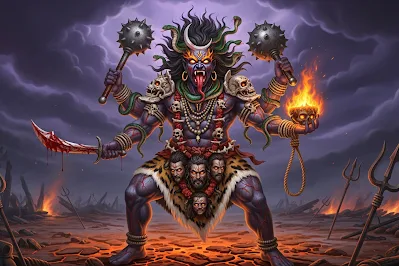Bhairava, the terrifying yet deeply sacred form of Shiva, is often misunderstood as merely a deity of destruction and wrath. In Tantric and Shakta traditions, however, Bhairava is far more than a fearsome presence—he is the vigilant guardian of divine feminine power, the protector of sacred thresholds, and an inseparable force that upholds and complements the energy of Shakti. In this blog, part of our ongoing Shakti series, we explore the Ashtabhairava—the eight principal categories of Bhairava—and why their presence is vital in the worship of the Goddess. Their fierce iconography, protective nature, and cosmic role make them essential to understanding the transformative path of Shakti sadhana.
Shri Bhairavaya Namaha
Why Bhairava Belongs in a Shakti Blog
To understand Shakti without Bhairava is to see only half the picture. In most sacred traditions—especially Tantra—the Goddess and Bhairava are not separate but are two aspects of the same consciousness. Shakti is dynamic energy; Bhairava is the unmoving, still presence that holds space for that energy to move.
- In Shakti Peeths, Bhairava is stationed as the guardian, ensuring the sanctity of the place where the Goddess’s energy resides.
- In Yogini cults, he is the axis of the mandala around which the Yoginis perform their divine dance.
- With the Ashtamatrikas, he pairs as the fierce masculine counterpart, completing the protective grid of cosmic balance.
Whether at a cremation ground or in a temple sanctum, Bhairava ensures that transformation is protected, potent, and pure.
The Eight Categories of Bhairava
The Ashtabhairavas are directional and symbolic manifestations of Bhairava energy. Each one governs a specific direction, is associated with a Matrika (Mother Goddess), and protects different thresholds of the cosmos and psyche.
Note: Each Bhairava has eight sub-Bhairavas, forming a total of 64—mirroring the 64 Yoginis.
1. Asitanga Bhairava (East)
- Names: Asitanga, Visalaksha, Martanda, Modaka, Amara, Mahabhaya, Aswini, Padma
- Consort: Brahmani
- Vehicle: Swan
- Symbolism: Creative void, emergence of form, guardian of the cosmic dawn
- Connection with Shakti: Protector of Adya Shakti (primordial energy). Asitanga aligns with Brahma-Shakti aspects and guards places of creation and origin.
2. Ruru Bhairava (Southeast)
- Names: Ruru, Krodha, Kapala, Rudraksha, Pralayantaka, Visvesha, Chandrachuda, Kapileshvara
- Consort: Maheshvari
- Vehicle: Bull
- Symbolism: Control over wild impulses, protection of dharma
- Connection with Shakti: Guardian of Yogini knowledge and Tantric wisdom. Ruru supports seekers in maintaining clarity and inner order.
3. Chanda Bhairava (South)
- Names: Chanda, Krodha, Pralaya, Ugra, Bheema, Durgesha, Rakta, Sarvesha
- Consort: Kaumari
- Vehicle: Peacock
- Symbolism: Overcoming demonic forces, active protector
- Connection with Shakti: Often invoked at entrances of Shakti Peeths, defending against malevolent energies. Works in tandem with warlike goddesses like Durga and Chamunda.
4. Krodha Bhairava (Southwest)
- Names: Krodha, Unmatta, Kapala, Pancha, Samhara, Pishitashana, Jatila, Akshaya
- Consort: Vaishnavi
- Vehicle: Eagle
- Symbolism: Sacred wrath, purging ego and ignorance
- Connection with Shakti: Mirrors the wrath of Matrikas. His power assists in the destruction of illusions and negative karma, enabling devotees to walk the path of spiritual transformation.
5. Unmatta Bhairava (West)
- Names: Unmatta, Bhishan, Chanda, Krodha, Samhara, Pishitashana, Jatila, Akshaya
- Consort: Varahi
- Vehicle: Horse
- Symbolism: Divine madness, ecstatic liberation
- Connection with Shakti: Resonates with the wild grace of Kali and Tripura Sundari. Leads practitioners to transcend duality and enter states of mystical rapture.
6. Kapala Bhairava (Northwest)
- Names: Kapala, Bhishma, Vyagra, Dhooli, Akshaya, Samhara, Jwalanta, Pralaya
- Consort: Indrani
- Vehicle: Elephant
- Symbolism: Skull-bearing detachment, dissolution of the ego
- Connection with Shakti: Deeply tied to Chinnamasta and Mahakali forms. His presence governs liminal spaces like cremation grounds, where transformation into higher states is most accessible.
7. Bhishana Bhairava (North)
- Names: Bhishana, Samhara, Agnivesha, Varada, Dhooli, Kapali, Kala, Mahabhaya
- Consort: Chamunda
- Vehicle: Corpse (Preta)
- Symbolism: Fearsome deterrent to evil, destroyer of black magic
- Connection with Shakti: A fierce protector of devotees and sacred sites. Often found guarding tantric temples, ensuring only the worthy may enter.
8. Samhara Bhairava (Northeast)
- Names: Samhara, Rudra, Bheema, Kapala, Samharamurti, Vishalaksha, Yoga, Nirvana
- Consort: Narasimhi or Chandika
- Vehicle: Lion
- Symbolism: Final dissolution, moksha, the burning of all illusions
- Connection with Shakti: Partner of Mahakali in the dance of cosmic dissolution. Guides the soul beyond birth and death into union with the absolute.
Bhairava and the Sacred Feminine
Every Shaktipeeth—whether in Kamakhya, Kashi, or Hinglaj—is guarded by a Bhairava. These are not symbolic pairings. Bhairava's fierce, time-bound nature complements the timeless energy of Shakti. Where she transforms, he protects. Where she flows, he anchors.
Similarly, the Ashta Matrikas and the 64 Yoginis are empowered through their connection with the Ashta Bhairavas. In Yogini temples, Bhairava often stands at the center, not to dominate but to hold space for the divine dance. This unity represents the sacred tantric truth: that stillness and motion, Shiva and Shakti, cannot exist in isolation.
A Note on Imagery
The images presented for each Bhairava category are intended to offer a general visual understanding of their archetypal energy. Each Bhairava has unique iconographic variations across regions, scriptures, and tantric sects, which we have not covered in this post.
Bhairava Is the Threshold
Bhairava is not just Shiva in a wrathful mood—he is the threshold consciousness. To walk the path of Shakti is to inevitably face Bhairava—at the cremation ground, at the edge of ego, at the gates of transformation.
We honor Bhairava not because he is separate from Shakti, but because he ensures her energy flows without obstruction. He is the fierce guardian of the sacred, the destroyer of illusion, and ultimately, the one who guides us through fear and darkness into divine realization.








